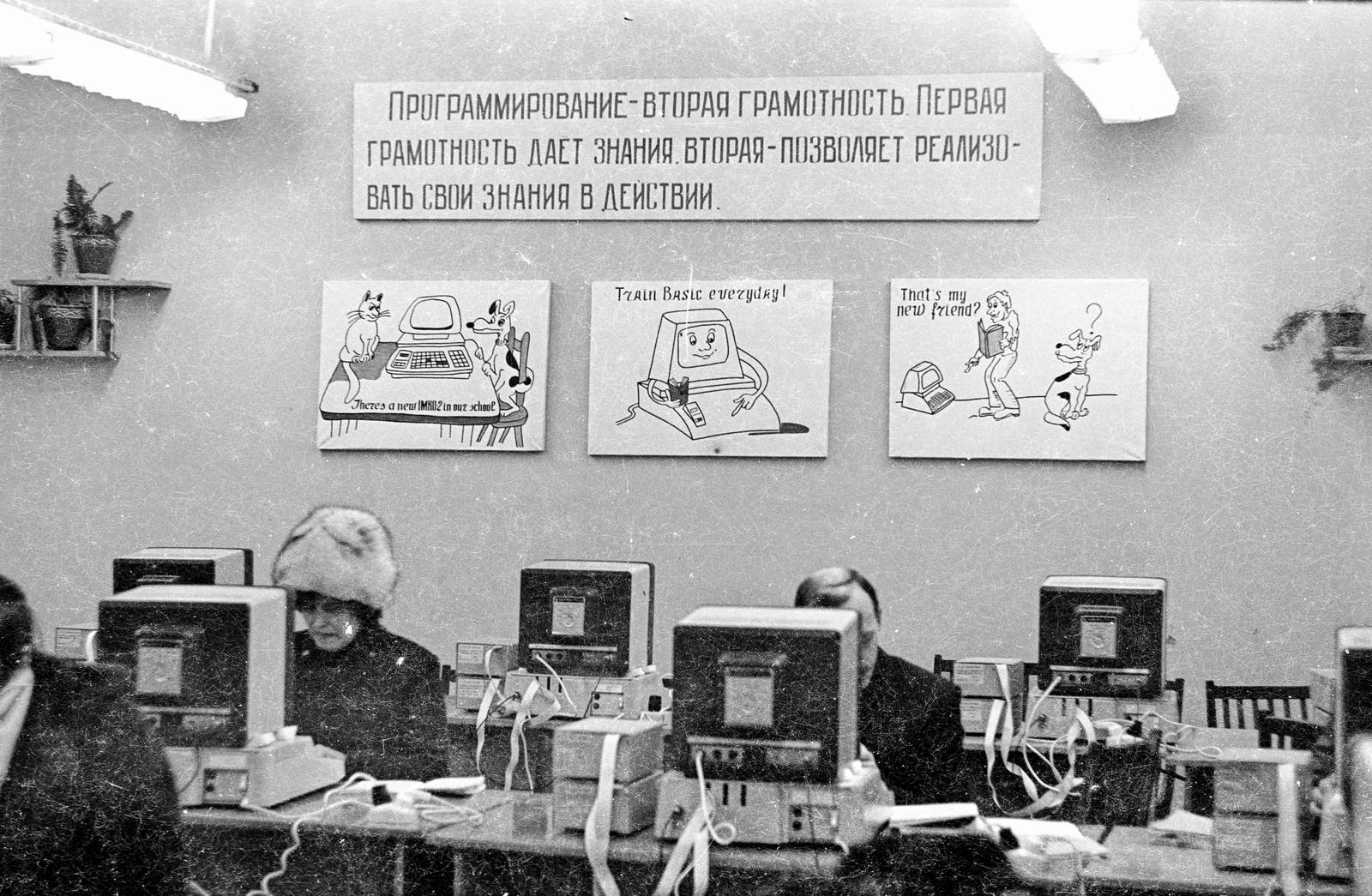|
History Of Computing In The Soviet Union
The history of computing in the Soviet Union began in the late 1940s, when the country began to develop its Small Electronic Calculating Machine (MESM) at the Kiev Institute of Electrotechnology in Feofaniya. Initial ideological opposition to cybernetics in the Soviet Union was overcome by a Khrushchev era policy that encouraged computer production. By the early 1970s, the uncoordinated work of competing government ministries had left the Soviet computer industry in disarray. Due to lack of common standards for peripherals and lack of digital storage capacity the Soviet Union's technology significantly lagged behind the West's semiconductor industry. The Soviet government decided to abandon development of original computer designs and encouraged cloning of existing Western systems (e.g. the 1801 CPU series was scrapped in favor of the PDP-11 ISA by the early 80s). Soviet industry was unable to mass-produce computers to acceptable quality standards and locally manufactured ... [...More Info...] [...Related Items...] OR: [Wikipedia] [Google] [Baidu] |
Konrad Zuse
Konrad Ernst Otto Zuse (; 22 June 1910 – 18 December 1995) was a German civil engineer, pioneering computer scientist, inventor and businessman. His greatest achievement was the world's first programmable computer; the functional program-controlled Turing-complete Z3 became operational in May 1941. Thanks to this machine and its predecessors, Zuse has often been regarded as the inventor of the modern computer. Zuse was noted for the S2 computing machine, considered the first process control computer. In 1941, he founded one of the earliest computer businesses, producing the Z4, which became the world's first commercial computer. From 1943 to 1945 he designed Plankalkül, the first high-level programming language. In 1969, Zuse suggested the concept of a computation-based universe in his book ('' Calculating Space''). Much of his early work was financed by his family and commerce, but after 1939 he was given resources by the government of Nazi Germany. [...More Info...] [...Related Items...] OR: [Wikipedia] [Google] [Baidu] |
Ural (computer)
Ural ( rus, Урал) is a series of mainframe computers built in the former Soviet Union. History The Ural was developed at the Electronic Computer Producing Manufacturer of Penza in the Soviet Union and was produced between 1956 and 1964. The computer was widely used in the 1960s, mainly in the socialist countries, though some were also exported to Western Europe and Latin America. The Indian Statistical Institute purchased an Ural-1 in 1958. When the University of Tartu received a new computer in 1965, its old Ural 1 was moved to a science-based secondary school, the Nõo Reaalgümnaasium, making the latter one of the first Soviet secondary schools to receive a computer. The name of the computer was also used to coin the first name for "computer" in Estonian, ''raal'', in use until the 1990s until it was replaced by the word ''arvuti'' ("computer"). School 444 in Moscow, Russia started graduating programmers in 1960 and had the Ural computer operating by its students on-prem ... [...More Info...] [...Related Items...] OR: [Wikipedia] [Google] [Baidu] |
Minsk Family Of Computers
''Minsk'' family of mainframe computers was developed and produced in the Byelorussian SSR from 1959 to 1975. Models The MINSK-1 was a vacuum-tube digital computer that went into production in 1960. The MINSK-2 was a solid-state digital computer that went into production in 1962. The MINSK-22 was a modified version of Minsk-2 that went into production in 1965. The MINSK-23 went into production in 1966. The most advanced model was ''Minsk-32'', developed in 1968. It supported COBOL, FORTRAN and ALGAMS (a version of ALGOL). This and earlier versions also used a machine-oriented language called ''AKI'' (''AvtoKod "Inzhener"'', i.e., " Engineer's Autocode"). It stood somewhere between the native assembly language ''SSK'' (''Sistema Simvolicheskogo Kodirovaniya'', or "System of symbolic coding") and higher-level languages, like FORTRAN. The word size was 31 bits for Minsk-1 and 37 bits for the other models. At one point the Minsk-222 (an upgraded prototype based on the most pop ... [...More Info...] [...Related Items...] OR: [Wikipedia] [Google] [Baidu] |
Lebedev Institute Of Precision Mechanics And Computer Engineering
Lebedev Institute of Precision Mechanics and Computer Engineering (IPMCE) is a Russian research institution. It used to be a Soviet Academy of Sciences organization in Soviet times. The institute specializes itself in the development of: * Computer systems for national security * Hardware and software for digital telecommunication * Multimedia systems for control and training * Positioning and navigational systems In August 2009 IPMCE became a joint-stock company. Computers developed by IPMCE * BESM-1 * BESM-2 * BESM-4 * BESM-6 BESM-6 (russian: БЭСМ-6, short for ''Большая электронно-счётная машина'', i.e. 'Large Electronic Calculating Machine') was a Soviet electronic computer of the BESM series. It was the first Soviet second-generatio ... * Elbrus-1 * Elbrus-2 * Elbrus-3 Programming, structured programming, task management, system programming developed by IPMCE * Эль-76 External links IPMCE anIPMCE References Co ... [...More Info...] [...Related Items...] OR: [Wikipedia] [Google] [Baidu] |
BESM
BESM (БЭСМ) is the name of a series of Soviet mainframe computers built in 1950–60s. The name is an acronym for "Bolshaya Elektronno-Schetnaya Mashina" ("Большая Электронно-Счётная Машина"), literally "Large Electronic Computing Machine". The series began as a successor to MESM ("Malaya Elektronno-Schetnaya Mashina", "Small Electronic Computing Machine"). MESM was built between 1948 and 1951 and was one of the first electronic computers produced in continental Europe. Models The BESM series included six models. BESM-1 ''BESM-1'', originally referred to as simply the BESM or BESM AN ("BESM Akademii Nauk", BESM of the Academy of Sciences), was completed in 1952. Only one BESM-1 machine was built. The machine used approximately 5,000 vacuum tubes. At the time of completion, it was the fastest computer in Europe. The floating-point numbers were represented as 39-bit words: 32 bits for the mantissa, one bit for sign, and 1 + 5 bits for the expone ... [...More Info...] [...Related Items...] OR: [Wikipedia] [Google] [Baidu] |
Or Control And Communication In The Animal And The Machine
Or or OR may refer to: Arts and entertainment Film and television * "O.R.", a 1974 episode of M*A*S*H * Or (My Treasure), a 2004 movie from Israel (''Or'' means "light" in Hebrew) Music * ''Or'' (album), a 2002 album by Golden Boy with Miss Kittin * ''O*R'', the original title of Olivia Rodrigo's album ''Sour'', 2021 * "Or", a song by Israeli singer Chen Aharoni in Kdam Eurovision 2011 * Or Records, a record label * Organized Rhyme, a Canadian hip-hop group featuring Tom Green Businesses and organizations * Or (political party) (), Israel * OR Books, an American publisher * Owasco River Railway, Auburn, New York, U.S. (by reporting mark) * TUI fly Netherlands, formerly ''Arke'', a Dutch charter airline (by IATA designator) Language and linguistics * Or (digraph), in the Uzbek alphabet * Or (letter) (or ''forfeda''), in Ogham, the Celtic tree alphabet * Odia language, an ancient Indo-Aryan tongue spoken in East India (ISO 639) * Or, an English grammatical conjunction * ... [...More Info...] [...Related Items...] OR: [Wikipedia] [Google] [Baidu] |
Norbert Wiener
Norbert Wiener (November 26, 1894 – March 18, 1964) was an American mathematician and philosopher. He was a professor of mathematics at the Massachusetts Institute of Technology (MIT). A child prodigy, Wiener later became an early researcher in stochastic and mathematical noise processes, contributing work relevant to electronic engineering, electronic communication, and control systems. Wiener is considered the originator of cybernetics, the science of communication as it relates to living things and machines, with implications for engineering, systems control, computer science, biology, neuroscience, philosophy, and the organization of society. Norbert Wiener is credited as being one of the first to theorize that all intelligent behavior was the result of feedback mechanisms, that could possibly be simulated by machines and was an important early step towards the development of modern artificial intelligence. Biography Youth Wiener was born in Columbia, Missouri, th ... [...More Info...] [...Related Items...] OR: [Wikipedia] [Google] [Baidu] |
Literaturnaya Gazeta
''Literaturnaya Gazeta'' (russian: «Литературная Газета», ''Literary Gazette'') is a weekly cultural and political newspaper published in Russia and the Soviet Union. It was published for two periods in the 19th century, and was revived in 1929. Overview The current newspaper shares its title with a 19th century publication, and claims to be a continuation of the original publication. The first paper to bear the name of ''Literaturnaya Gazeta'' was founded by a literary group led by Anton Delvig and Alexander Pushkin, whose profile to this day adorns the paper's masthead. The first issue appeared on January 1, 1830. The paper appeared regularly until June 30, 1831, reappearing in 1840–1849. Pushkin himself published some of his most famous works in this paper. ''Literaturnaya Gazeta'' was the first to publish Gogol, and published works by Baratynsky, Belinsky, Nekrasov and many other Russian authors. After the Russian Revolution, the Soviet literary e ... [...More Info...] [...Related Items...] OR: [Wikipedia] [Google] [Baidu] |
Joseph Stalin
Joseph Vissarionovich Stalin (born Ioseb Besarionis dze Jughashvili; – 5 March 1953) was a Georgian revolutionary and Soviet political leader who led the Soviet Union from 1924 until his death in 1953. He held power as General Secretary of the Communist Party of the Soviet Union (1922–1952) and Chairman of the Council of Ministers of the Soviet Union (1941–1953). Initially governing the country as part of a collective leadership, he consolidated power to become a dictator by the 1930s. Ideologically adhering to the Leninist interpretation of Marxism, he formalised these ideas as Marxism–Leninism, while his own policies are called Stalinism. Born to a poor family in Gori in the Russian Empire (now Georgia), Stalin attended the Tbilisi Spiritual Seminary before joining the Marxist Russian Social Democratic Labour Party. He edited the party's newspaper, '' Pravda'', and raised funds for Vladimir Lenin's Bolshevik faction via robberies, kidnappings and p ... [...More Info...] [...Related Items...] OR: [Wikipedia] [Google] [Baidu] |



.jpg)

